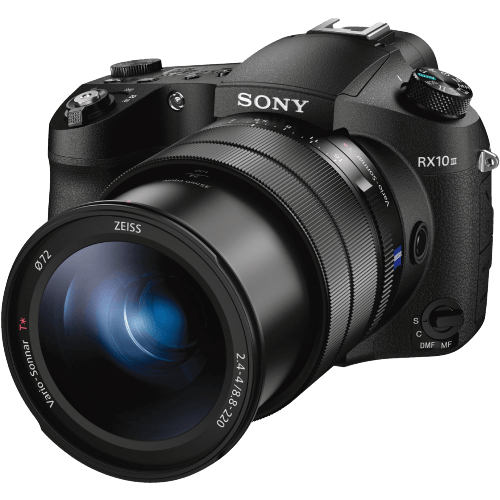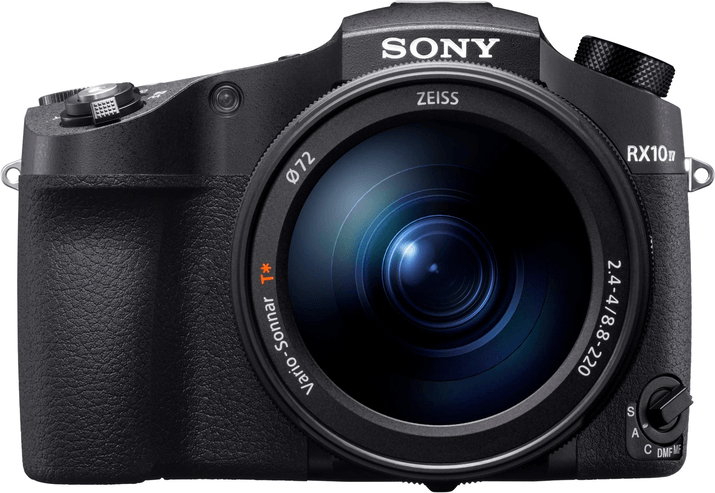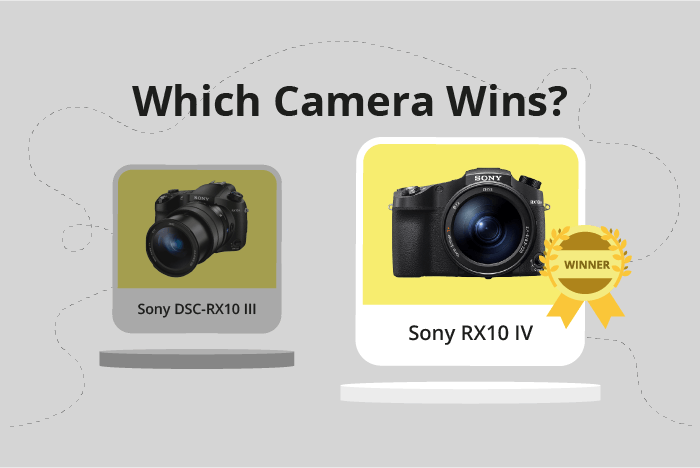Sony Cyber-shot DSC-RX10 III vs Cyber-shot RX10 IV Comparison
Sony Cyber-shot DSC-RX10 III

Sony Cyber-shot RX10 IV

The Sony Cyber-shot RX10 IV takes the lead with a score of 70/100, while the Sony Cyber-shot DSC-RX10 III follows with 63/100. Both cameras share the same bridge camera type, similar dimensions (133 x 94mm), and were released within a year of each other (2016 and 2017). They also have a close weight, with the RX10 IV weighing 1095g and the RX10 III at 1051g.
The RX10 IV has a higher score due to its improved features and performance. It justifies its higher launch price of $1699 compared to the RX10 III’s $1499. On the other hand, the RX10 III still offers great value with its lower price and slightly lighter weight.
Considering the specifications and scores, the Sony Cyber-shot RX10 IV is a better camera choice for those seeking advanced features and performance. However, the RX10 III remains a solid option for those on a tighter budget or who prioritize a lighter camera.
Sony Cyber-shot DSC-RX10 III vs Cyber-shot RX10 IV Overview and Optics
The Sony Cyber-shot RX10 IV outperforms the Sony Cyber-shot DSC-RX10 III in optics, with scores of 68/100 and 63/100, respectively. Both cameras share several common specifications, including 20-megapixel resolution, CMOS sensor type, Bionz X processor, 1″ sensor size, fixed lens mount, and image stabilization.
The RX10 IV’s higher score is due to its faster shooting speed of 24 frames per second compared to the RX10 III’s 14 frames per second. This enables the RX10 IV to capture fast-moving subjects with greater ease and precision. Additionally, the RX10 IV’s sensor has a higher DXOMARK score of 82, compared to the RX10 III’s score of 70. This indicates that the RX10 IV’s sensor provides better image quality, dynamic range, and low-light performance.
The RX10 III, despite its lower score, still offers good optical performance. Its 20-megapixel resolution, CMOS sensor, and Bionz X processor are the same as the RX10 IV, ensuring high-quality images. The RX10 III also has image stabilization, making it suitable for handheld shooting and reducing the chances of blurry images.
Given these comparisons, the RX10 IV is the superior camera in terms of optics due to its faster shooting speed and higher sensor performance. However, the RX10 III remains a competent choice for photographers seeking a camera with good optical performance and image stabilization. Ultimately, the decision between these two cameras will depend on the individual’s preferences and priorities, such as shooting speed and sensor quality.
Sony Cyber-shot DSC-RX10 III vs Cyber-shot RX10 IV Video Performance
The Sony Cyber-shot RX10 IV outperforms the Sony Cyber-shot DSC-RX10 III in video capabilities with a score of 77/100 compared to the latter’s 64/100. Both cameras share some common features, such as a maximum video frame rate of 120fps and lack of built-in time-lapse functionality.
The RX10 IV excels in its video quality due to its 4K maximum video resolution, which is significantly higher than the RX10 III’s Full HD resolution. This results in sharper and more detailed videos captured by the RX10 IV. Additionally, the RX10 IV’s maximum video dimensions are 3840 x 2160, which is double the RX10 III’s dimensions of 1920 x 1080. This larger video size allows for better editing and cropping options in post-production.
The RX10 III does not have any clear advantages over the RX10 IV in terms of video capabilities. Its lower video resolution and dimensions make it less suitable for professional video production or for users who demand high-quality footage.
Considering these factors, the Sony Cyber-shot RX10 IV is the better choice for those looking for superior video capabilities in their camera. The higher resolution and larger video dimensions offer a significant improvement over the RX10 III, making it a more suitable option for professionals or enthusiasts seeking top-notch video quality. While the RX10 III may still be a viable option for casual users or those on a tighter budget, the RX10 IV’s superior video performance justifies its higher score and makes it the clear winner in this comparison.
Sony Cyber-shot DSC-RX10 III vs Cyber-shot RX10 IV Features and Benefits
The Sony Cyber-shot RX10 IV outperforms the Sony Cyber-shot DSC-RX10 III with a feature score of 83/100 compared to 70/100. Both cameras share several specifications, including a 3-inch screen size, touchscreen capabilities, flip screen, WIFI connectivity, and the absence of GPS.
The RX10 IV has a higher screen resolution of 1,440,000 dots, compared to the RX10 III’s 1,228,800 dots. This higher resolution provides a clearer and more detailed display for capturing and reviewing images. Additionally, the RX10 IV features Bluetooth connectivity, which the RX10 III lacks. This enables users to easily transfer images to other devices and use additional accessories without the need for cables or adapters.
Despite its lower feature score, the RX10 III still offers some advantages. With both cameras having a touchscreen, flip screen, and WIFI capabilities, users can enjoy similar levels of convenience and flexibility in their photography experience. Moreover, the absence of GPS in both cameras means that neither model has an advantage in terms of location tracking and geotagging.
In comparing the two cameras, the Sony Cyber-shot RX10 IV proves to be the superior option due to its higher screen resolution and Bluetooth connectivity. These features enhance the user experience by offering a clearer display and more seamless connectivity options. On the other hand, the RX10 III remains a viable choice for those who prioritize touchscreen functionality, flip screen, and WIFI capabilities without the need for additional features such as Bluetooth or GPS. Ultimately, the choice between these two cameras depends on the user’s specific requirements and preferences.
Sony Cyber-shot DSC-RX10 III vs Cyber-shot RX10 IV Storage and Battery
The Sony Cyber-shot RX10 IV outperforms the Sony Cyber-shot DSC-RX10 III in storage and battery with a score of 37/100 compared to 24/100. Both cameras share the same specifications in terms of memory card slots and the types of memory cards accepted. They each have one memory card slot and support SD, SDHC, SDXC, as well as Memory Stick Duo, Pro Duo, and Pro-HG Duo cards.
The RX10 IV is superior due to its USB charging capability, which the RX10 III lacks. This feature allows for more convenient charging options. However, the RX10 III has a slightly better battery life, providing 420 shots per charge compared to the RX10 IV’s 400 shots. Despite a minor advantage in battery life, the RX10 III’s absence of USB charging ultimately places it behind the RX10 IV.
Considering these factors, the RX10 IV’s higher score in storage and battery is justified, making it the better choice for users who prioritize convenience and charging options.
Sony Cyber-shot DSC-RX10 III vs Cyber-shot RX10 IV – Our Verdict
Are you still undecided about which camera is right for you? Have a look at these popular comparisons that feature the Sony Cyber-shot DSC-RX10 III or the Sony Cyber-shot RX10 IV:

